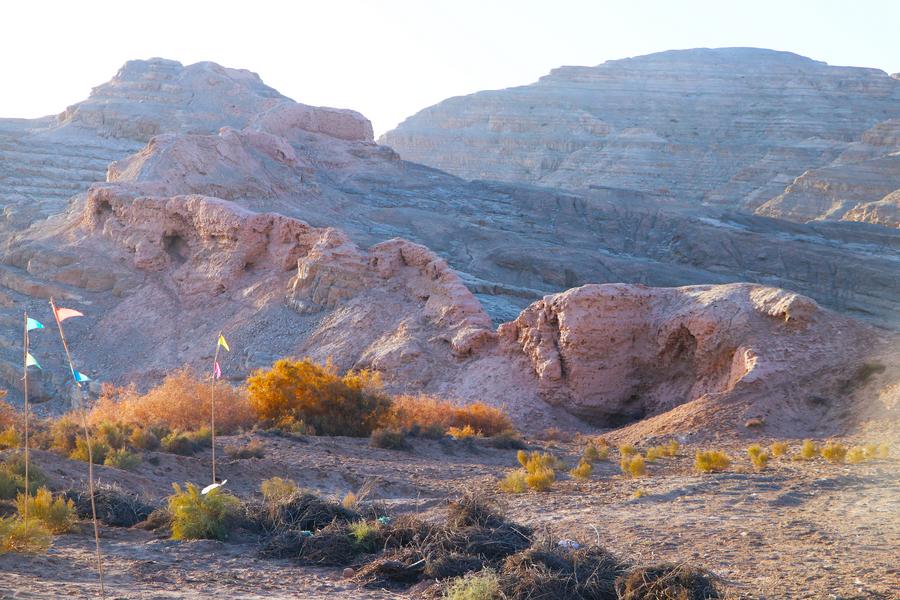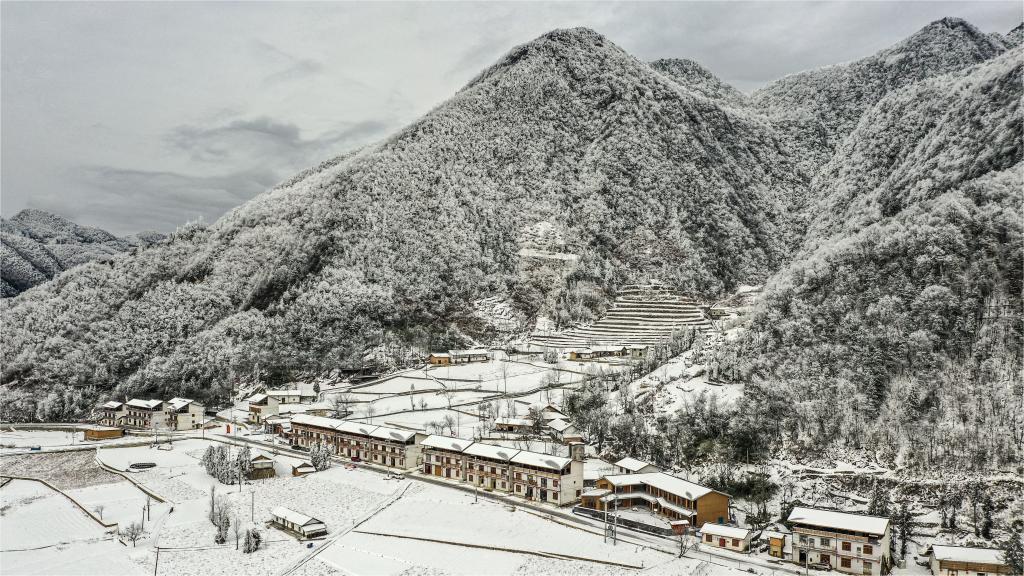Diverse culture empowers ancient Silk Road hub's modern development
URUMQI, Jan. 25 (Xinhua) -- At the northwestern edge of the Taklimakan Desert, China's largest desert, known as the "Sea of Death," a modern oasis city has emerged over a period of two decades. About some 10 kilometers north of the downtown area, the ruins of an ancient city sit on a mountain, with beacon towers on the peak and shrines among the cliffs.
The 20-year-old modern city and the ancient ruins dating back some 2,000 years are both part of the city of Tumxuk in northwest China's Xinjiang Uygur Autonomous Region. Envoys, merchants, farmers, overseas sinologists and archaeologists have all left their footprints in Tumxuk, and their contributions have empowered the city's modern development.
DIVERSE, VITAL CULTURAL SPOT
Locals named the ancient ruins Tangwangcheng, which means "Tang King City," as they found coins there dating back to the Tang Dynasty (618-907), according to historical documents. Ancient ramparts, columns and fossil river courses, among other structures, can be seen among the ruins, which cover more than 700,000 square meters.

This photo taken on Nov. 25, 2023 shows part of the ancient ruins Tangwangcheng in Tumxuk City, northwest China's Xinjiang Uygur Autonomous Region. (Xinhua/Zhao Chenjie)
According to Lin Meicun, a professor at the School of Archaeology and Museology, Peking University, the relics bear witness to the ancient Silk Road. Having studied various unearthed documents and relics, such as ancient chariot accessories unearthed in Tangwangcheng and its surroundings, Lin believes that the ruins are those of "Pantuo City", as mentioned in official historical texts.
Envoys and merchants from the central part of China used the ancient Silk Road to transport silk fabrics, and spread iron-smelting and well-digging technology westward, at the same time adopting the grapes and alfalfa of the country's western region, according to archaeologists.
However, Tangwangcheng may no longer have been habitable during in the Song Dynasty (960-1279), said Li Zongqian, director of Xinjiang reclamation history museum in Tumxuk. "At that time, as natural conditions deteriorated, the river near Tangwangcheng stopped flowing and people could no longer farm or live here," said Li.
In the late 19th century and early 20th century, expeditionists from countries, including France, Britain and Germany, took relics away from China, but they also aroused the world's interest in the ancient culture of Xinjiang and the Silk Road civilization. Meanwhile, Chinese academicians were also becoming interested, and generations of Chinese archaeologists have subsequently investigated relics in Xinjiang, including at Tangwangcheng.

This photo taken on Nov. 25, 2023 shows part of the ancient ruins Tangwangcheng in Tumxuk City, northwest China's Xinjiang Uygur Autonomous Region. (Xinhua/Zhao Chenjie)
Tangwangcheng was one of the cultural heritage sites placed under national-level protection in 2001. In the past two years, national and Xinjiang institutions have jointly conducted two phases of investigations and excavations on the site of Tangwangcheng.
In the first phase, archaeologists unearthed over 500 antique objects, such as bronze mirrors, monkey-shaped Buddha statues, pottery and coins of the Tang Dynasty, with over 40 items exhibited at the Xinjiang reclamation history museum.
"Tangwangcheng is a rare comprehensive relics site. It provides important information for us to explore the social life, religious beliefs and cultural exchanges between the East and the West in Xinjiang," said Yang Rui, the archaeological excavation team leader of Tangwangcheng.
Yan Panning, a resident of Tumxuk, started working as a guide at the Xinjiang reclamation history museum last year. She said the job has deepened her understanding of Tumxuk's profound history.
"The cultural relics, such as Gandhara sculptures and colorful murals, represent Tumxuk's image," said Yan. "I hope to tell the story of Tangwangcheng to more people."
GREEN, MODERN CITY
Based on the profound and diverse culture, the ancient Silk Road hub has ushered in a new chapter in modern development in recent decades.

An aerial drone photo taken on Aug. 18, 2023 shows the city view of Tumxuk City, northwest China's Xinjiang Uygur Autonomous Region. (Photo by Meng Jiuting/Xinhua)
Since the founding of the People's Republic of China in 1949, the central government has mobilized people to develop Xinjiang's desert regions, which nowadays includes Tumxuk and its surrounding regions. People gradually reclaimed land, dug canals, built houses and roads, and planted crops and trees.
Jinxiu Park in downtown Tumxuk is now a place for citizens to stroll, dance and work out. Resident Mehmut Tursen recalls that, a few decades ago, the place was frequently assaulted by sandstorms.
"The sand hurt my face and I could barely keep my eyes open at that time," said Mehmut Tursen. "That's why we are willing to plant more trees. Trees can fight against yellow sand."
These days, Tumxuk adheres to the principle of harmonious co-existence between people and nature. Around 50 percent of the city's land area consists of urban green areas, while water is provided by six reservoirs with a designed total storage capacity of 830 million cubic meters in 2022. The city's population has grown from 110,000 when it was established in 2004 to over 300,000 now.
In the city's Xing'an Township, the desert has been made productive, with over 1,066 hectares of tiger nuts harvested last year. The crop is drought-tolerant, saline-resistant and can improve the soil, while the resulting nuts can be used for oil, grain and forage.
According to Li Yinqiong, head of the agricultural development service center of Xing'an Township, tiger nuts have provided 900 jobs for locals and can generate a net income of 2,000 yuan (about 281.52 U.S. dollars) per hectare.
"Tiger nuts have high economic value, and the stems and leaves can be used to feed livestock, so we built a breeding base that can raise thousands of cattle," said Li Yinqiong, adding that Xing'an plans to develop flour, beverages and other products using tiger nuts as raw materials.
In the first three quarters of last year, Tumxuk saw a GDP growth of 9.1 percent. Currently, there are more than 7,600 enterprises in Tumxuk, of which more than 6,600 are in the private sector.

An aerial drone photo taken on Dec. 1, 2023 shows vehicles running on a bridge through a desert poplar (populus euphratica) forest in Tumxuk City, northwest China's Xinjiang Uygur Autonomous Region. (Photo by Zhao Chengwei/Xinhua)
Tumxuk is close to the land ports of Khunjerab, Torugart and Irkeshtam, linking it with Belt and Road partners. It has also established air routes connecting it with cities in Xinjiang, as well as Beijing, Chengdu, Lanzhou and other places in China. Finally, it enjoys the advantages brought by the Kashgar Area of China (Xinjiang) Pilot Free Trade Zone.
Having witnessed the birth of Tumxuk 20 years ago, Xie Jiagui, dean of the research institute of Tangwangcheng history and culture, said he could hardly have imagined the city's fast-track development. The 62-year-old Xie is still engaged in the research of Tangwangcheng and Tumxuk.
"Tracing the history of Tumxuk is important for understanding people who once lived on this land and what happened here," said Xie. "I hope to seek experience from the past to serve Tumxuk's modern development."
Photos
Related Stories
- Xinjiang Story: Quake-resistant houses provide secure haven for herders
- Kids enjoy sharing birthday cakes at resettlement site in Xinjiang's Wushi County
- China's Xinjiang posts robust foreign trade growth in 2023
- Side event on human rights and Chinese modernization held by NGO in Geneva
- Commentary: Lies about China reveal Western hypocrisy
Copyright © 2024 People's Daily Online. All Rights Reserved.









